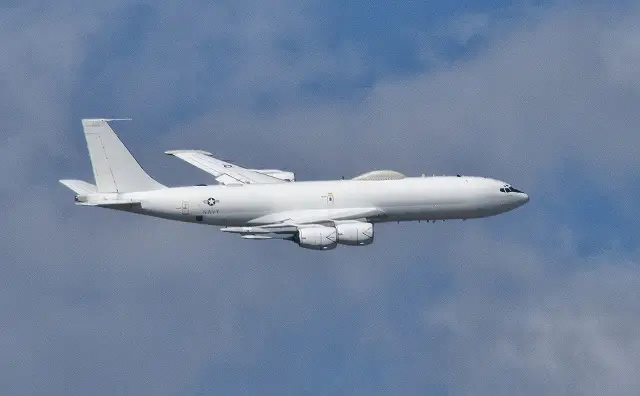|
|
| a |
Naval
Forces News - USA |
| |
|
| |
| |
Maintenance
for U.S. Navy's Boeing E-6B Mercury Airborne Command Post Aircraft |
| |
The
U.S. Navy's Naval Air Systems Command (NAVAIR) awarded two contracts
for the maintenance of the Boeing E-6B Mercury airborne command post.
The E-6B is a dual-mission aircraft providing either airborne command,
control, and communications or serving as an airborne strategic command
post and is equipped with an airborne launch control system capable
of launching U.S. land based intercontinental ballistic missiles |
|

A U.S. Navy Boeing E-6B Mercury airborne command post flies over Solomons
Island, Maryland (USA), on 15 November 2014. The E-6B is a dual-mission
aircraft providing either airborne command, control, and communications
or serving as an airborne strategic command post and is equipped with
an airborne launch control system capable of launching U.S. intercontinental
ballistic missiles.
U.S. Navy photo |
|
According
to the contract announcements, DRS was awarded a contract for logistics
support for maintaining and supporting the E-6B aircraft while Rockwell
Collins received a contract option for the manufacturing of one Block
I modification aircraft kit and one very low frequency transmit terminal
kit for the E-6B Mercury aircraft.
Two squadrons, the "Ironmen" of VQ-3 and the "Shadows"
of VQ-4 deploy 22 aircrews (for 16 aircraft) from Tinker Air Force Base,
Okla. to meet these requirements.
Boeing derived the E-6A from its commercial 707 to replace the aging
EC-130Q in the performance of the Navy's TACAMO ("Take Charge and
Move Out") mission. TACAMO links the National Command Authority
with naval ballistic missile forces during times of crisis. The aircraft
carries a very low frequency communication system with dual trailing
wire antennas. The Navy accepted the first E-6A in August 1989.
The E-6B was conceived as a replacement for the Air Force's Airborne
Command Post due to the age of the EC-135 fleet. The E-6B modified an
E-6A by adding battlestaff positions and other specialized equipment.
The E-6B is a dual-mission aircraft capable of fulfilling either the
E-6A mission or the airborne strategic command post mission and is equipped
with an airborne launch control system (ALCS). The ALCS is capable of
launching U.S. land based intercontinental ballistic missiles. The first
E-6B aircraft was accepted in December 1997 and the E-6B assumed its
dual operational mission in October 1998. The E-6 fleet was completely
modified to the E-6B configuration in 2003. |